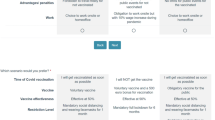Abstract
In this paper we discuss the application of different co-payment rates to alternative medical strategies. Two such strategies are considered: a “vaccination strategy”, in which patients apply preventive measures before knowing if they have the disease, and a “wait and treat” strategy, in which patients are treated later only if they contract the disease. We show the second approach should be more generously subsidized by the regulator. This is, at least at first sight, a surprising result.
Similar content being viewed by others
Notes
They are mutually exclusive for each patient. Globally, however, one strategy may be applied to one group of patients and the other to another group.
One might consider that the vaccination induces side effects but we avoid this complication in this model.
The term “wait and treat” was recently used by Lejeune et al. (2005) in an empirical study of prophylaxis with valaciclovir. There are many similarities between their empirical analysis and our theoretical model.
Of course we exclude by assumption the situation in which no treatment at all would be efficient. This assumption is formally stated in Eq. (1).
Notice that if the patient were very risk averse \({\hat{\upsigma}_{{\rm{LF}}}}\) might be very close to zero.
Indeed, to obtain H 2 for one sick patient with the “wait and treat” strategy, the marginal cost is \({\tilde{{C}}.}\) However to obtain H 2 for one sick patient with vaccination this strategy has to be applied to \({\frac{1}{{\hat{\upsigma}}}}\) patients, resulting in a cost equal to \({\frac{C}{\hat{\upsigma}}}.\)
As correctly observed by Byrne and Thompson (2001) in a slightly different, but quite closely related, context, “the use of subsidies or financial incentives in health is not a new idea, although there are few economic models outside of the insurance literature”. Besides the few exceptions quoted by the authors, let us mention a very stimulating paper by Breyer (1982).
The SOC for a maximum are not easily checked because they involve the slope of the density function \({{f}({\upsigma})}\) which can be of any sign.
To look at the ex ante welfare we use a concave transformation, U, of the expected utility of each individual \({{\upsigma}}.\) In that case the ex ante worst position is that of individuals with the highest \({{\upsigma},}\) who have chosen long term treatment. Namely,
$$ {U}{( {\upsigma _{ + } })} = {U}{\left[ {\upsigma _{ + } {u}{\left( {{y}{\left( {1 - \tau } \right)}{c}{\left( {1 - {s}} \right)}} \right)} + {\left( {1 - \upsigma _{ + } } \right)}{u}{\left( {{y}{\left( {1 - \tau } \right)}} \right)} + {\left( {1 - \upsigma _{ + } } \right)}{H} + \upsigma _{ + } {\left( {{H}_{0} + {b}} \right)}} \right]}, $$where \({{\upsigma}_+}\) is the highest value of \({{\upsigma}.}\) It is pretty clear that with this position the Rawlsian criterion would imply investing all resources in subsidizing long-term care treatment. Whatever the model adopted, however, the case seems strong in favor of no uniformity in co-payment rates.
References
Atkinson, A.B., Stiglitz, J.: Lectures on Public Economics. McGraw Hill, London (1980)
Breyer, F.: “Rational” purchase of medical care and differential insurance coverage for diagnostic services. J. Health Econ. 1, 147–156 (1982)
Byrne, M., Thompson, P.: Screening and preventable illness. J. Health Econ. 20, 1077–1088 (2001)
Eeckhoudt, L., Gollier, C.: The insurance of lower probability events. J. Risk Insur. 16, 17–28 (1999)
Lejeune, C., Beard, S., Crochard, A., Lebranchu, Y., Ponteille-Noble, C., Richter, A., Durand-Zaleski, I.: The cost-effectiveness of prophylaxis with valaciclovir in the management of cytomegalovirus after renal transplantation. Eur. J. Health Econ. 6, 172–182 (2005)
Acknowledgments
Preliminary versions of this paper were presented at the 4th European Conference on Health Economics (Paris, 2002), at Konstanz Universität (2003) at the University of Montpellier (2003) and at the European Workshop on Health Economics (Liège, 2005). We thank participants at these conferences for their comments and especially F. Schroyen, our discussant in Liège. We are also grateful to the referees for their evaluation. This paper was started before our colleague M. Marchand passed away in July 2003. Conflict of interest: none.
Author information
Authors and Affiliations
Corresponding author
Additional information
M. Marchand: Deceased.
Rights and permissions
About this article
Cite this article
Eeckhoudt, L., Marchand, M., Pestieau, P. et al. Vaccination versus “wait and treat”: how to subsidize them?. Eur J Health Econ 9, 33–39 (2008). https://doi.org/10.1007/s10198-006-0026-1
Received:
Accepted:
Published:
Issue Date:
DOI: https://doi.org/10.1007/s10198-006-0026-1




